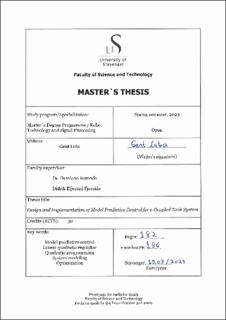| dc.contributor.advisor | Rotondo, Damiano | |
| dc.contributor.advisor | Efjestad Fjereide, Didrik | |
| dc.contributor.author | Luta, Gent | |
| dc.date.accessioned | 2023-08-25T15:51:14Z | |
| dc.date.available | 2023-08-25T15:51:14Z | |
| dc.date.issued | 2023 | |
| dc.identifier | no.uis:inspera:129730556:34096996 | |
| dc.identifier.uri | https://hdl.handle.net/11250/3085853 | |
| dc.description.abstract | Modellprediktiv kontroll (MPC) er en kontrollteknikk som optimaliserer, over de manipulerte inngangene, fremtidige prognoser til et dynamisk system.
Gitt en objektiv funksjon, bruker MPC en prediksjonsmodell (som matematisk prøver å kapsle inn den dynamiske oppførselen til et system så nøyaktig som mulig) og en optimaliseringsalgoritme for å finne de optimale manipulerte inngangene, som, når de brukes på prediksjonsmodellen, resulterer i en forutsagt prognose som minimerer den objektive funksjonen.
MPC følger en 'receding horizon' kontroll regel, som innebærer at optimaliseringsprosedyren beregnes over et begrenset horisontvindu. Når optimaliseringen er fullført, blir bare den første beregnede optimalt manipulerte inngangen tilført systemet, og resten blir forkastet. Det endelige horisontvinduet forskyves deretter med et tidsforløp, og prosedyren gjentas 'ad infinitum'.
Dette prosjektet undersøker fire typer MPC: (i) lineær-, (ii) eksplisitt-, (iii) adaptiv-, (iv) og ikke-lineær-MPC. Det er vist at, for et 'multi-input', koblet, hurtigsamplet tanksystem, gir de fire MPC-typene tilstrekkelig kontroll med hensyn til settpunktsporing og forstyrrelsesavvisning. Videre er det vist at en MPC kan gi signalforhåndsvisningsfunksjoner så vel som avkoblingsfunksjoner, samtidig som den er utsatt for begrensninger på de kontrollerte utgangene, manipulerte inngangene og de manipulerte inngangshastighetene. De nevnte observasjonene er vist ved bruk av simuleringsresultater og eksperimentelle resultater fra tanksystemet.
I tillegg blir mer tradisjonelle kontrollteknikker som LQR- og PID-baserte kontroller evaluert på lignende måte som de fire MPC-typene. Det er vist at ytelsen til kontrollerene, med hensyn til ytelsesindeksen for integral av absolutt feil (IAE), kan rangeres i den påfølgende rekkefølgen (fra best til dårligst): (i) ikke-lineær-MPC, (ii) lineær-MPC, (iii) eksplisitt-MPC, (iv) LQR-basert kontroller, (v) adaptiv-MPC, (vi) PID-kontroller med 'feedforward'-kontrollhandling og en lineær 'decoupler', (vii) PID-kontroller med 'feedforward'-kontrollhandling, og til slutt, (viii) PID-kontroller.
Til slutt er det vist at lineær-, eksplisitt- og adaptiv-MPC er i stand til å gi gjennomførbare styring med et samplingsintervall 0,1 sekunder. En gjennomførbar styring innebærer at MPC-en er i stand til å beregne optimaliseringsprosedyren innenfor tidsrammen for ett tidsforløp. For den ikke-lineære MPC-en er det vist at denne kontrolleren gir en gjennomførbar styring med et samplingsintervall på 0,5 sekunder. Disse observasjonene er vist ved hjelp av eksperimentelle resultater fra tanksystemet, i tillegg til simuleringsresultater. | |
| dc.description.abstract | Model predictive control (MPC) is a control technique that optimizes, over the manipulated inputs, future trajectories of a dynamic system.
Given an objective function, the MPC uses a prediction model (which mathematically tries to encapsulate the dynamic behaviour of a system as accurately as possible) and an optimization algorithm in order to find the optimal manipulated inputs, which, when applied to the prediction model, results in a predicted trajectory that minimizes the objective function.
Model predictive control follows the receding horizon control policy, which implies that the optimization procedure is computed over a finite horizon window. When the optimization is completed, only the first calculated optimal manipulated input is applied to the system, and the rest are discarded. The finite horizon window then shifts by one sample, and the procedure is repeated ad infinitum.
This project investigates four types of model predictive controllers: (i) linear-, (ii) explicit-, (iii) adaptive-, (iv) and nonlinear-MPC. It is shown that, for a multi-input, coupled, fast-sampled tank system, the four types of model predictive controllers provide adequate control in regards to set-point tracking and disturbance rejection. Furthermore, it is shown that a model predictive controller can provide signal previewing functions as well as decoupling functions, while also being subjected to constraints on the controlled outputs, manipulated inputs, and the manipulated input rates. The aforementioned observations are shown using simulation results and experimental results from the tank system.
Additionally, more traditional control techniques such as LQR-, and PID-based controllers are evaluated in a similar manner as the four model predictive controllers. It is shown that the performance of the controllers, with regards to the integral of absolute error (IAE) performance index, can be ranked in the subsequent order (from best to worst): (i) nonlinear-MPC, (ii) linear-MPC, (iii) explicit-MPC, (iv) LQR-based controller, (v) adaptive-MPC, (vi) PID feedback controller with feedforward control action and a linear decoupler, (vii) PID feedback controller with feedforward control action, and lastly, (viii) PID feedback controller. These observations are shown using experimental results from the tank system.
Lastly, it is shown that the linear-, explicit-, and adaptive-MPC are able to provide feasible control policies with a sampling interval of 0.1 seconds. A feasible control policy implies that the model predictive controller is able to calculate the optimization procedure within the time frame of one sample. For the nonlinear MPC, it is shown that this controller provides a feasible control policy with a sampling interval of 0.5 seconds. These observations are shown using experimental results from the tank system, in addition to simulation results. | |
| dc.language | eng | |
| dc.publisher | uis | |
| dc.title | Design og implementering av modellprediktiv kontroll for et koplet tanksystem | |
| dc.type | Master thesis | |
